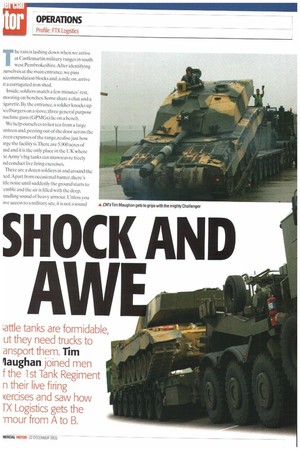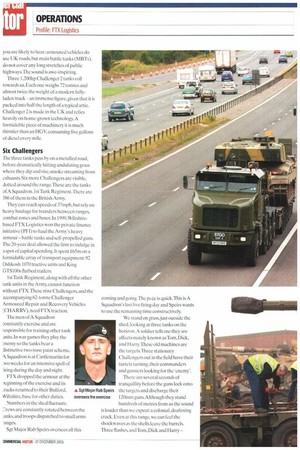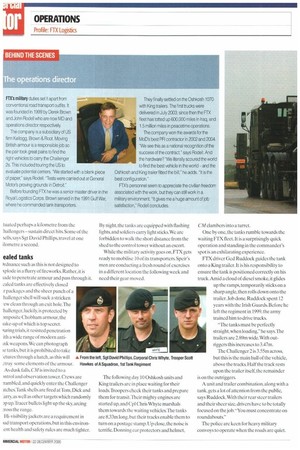sHock AND
Page 46

Page 48

Page 50

Page 51

If you've noticed an error in this article please click here to report it so we can fix it.
AW
;a-ale tanks are formidable,
ut they need trucks to
ansport them. Tim iaughan joined men
f the 1st Tank Regiment n their live firing Kercises and saw how LX Logistics gets the
-mour from A to B. The rain is lashing down when we arrive at Castlemartin military ranges in south west Pembrokeshire.After identifying Jurselves at the main entrance, we pass iccommodation blocks and, a mile on, arrive it a corrugated iron shed.
Inside, soldiers snatch a few minutes' rest, a ;noozing on benches. Some share a chat and a igarette. By the entrance, a soldier knocks up xefburgers on a stove: three general purpose nachine guns (GPMGs) lie on a bench. We help ourselves to hot tea from a large .anteen and, peering out of the door across the Teen expanses of the range, realise just how irge the facility is.There are 5.900 acres of Ind and it is the only place in the UK where me Army's big tanks can manoeuvre freely nd conduct live firing exercises.
There are a dozen soldiers in and around the led. Apart from occasional banter, there's ttle noise until suddenly the ground starts to .emble and the air is filled with the deep, .undling sound of heavy armour. Unless you ave access to a military site, it is not a sound A CMtTim Maughan gets to grips with the mighty Challenger you are likely to hear: armoured vehicles do use UK roads, but main battle tanks (MBTs), do not cover any long stretches of public highways.The sound is awe-inspiring.
Three 1200hp Challenger 2 tanks roll towards us. Each one weighs 72 tonnes and almost twice the weight of a modern fullyladen truck an immense figure, given that it is packed into half the length of a typical artic. Challenger 2 is made in the UK and relies heavily on home-grown technology. A formidable piece of machinery it is much thirstier than an HGV, consuming five gallons of diesel every mile.
Six Challengers The three tanks pass by on a metalled road, before dramatically hitting undulating grass where they dip and rise, smoke streaming from exhausts. Six more Challengers are visible, dotted around the range.These are the tanks of A Squadron, 1st Tank Regiment.There are 386 of them in the British Army.
They can reach speeds of 37mph, but rely on heavy haulage for transfers between ranges, combat zones and bases. In 1999,Wiltshirebased FTX Logistics won the private finance initiative (MI) to haul the Army's heavy armour —battle tanks and self-propelled guns. The 20-year deal allowed the firm to indulge in a spot of capital spending. It spent £65m on a formidable array of transport equipment:92 Oshkosh 1070 tractive units and King GTS100s flatbed trailers.
1st Tank Regiment,along with all the other Lank units in the Army, cannot function without FTX.These nine Challengers, and the accompanying 62-tonne Challenger Armoured Repair and Recovery Vehicles (CHARRV), need FTX traction.
The men of A Squadron constantly exercise and are responsible for training other tank units. In war games they play the enemy so the tanks bear a distinctive two-tone paint scheme. A Squadron is at Castlemartin for :wo weeks for an intensive spell of iring during the day and night.
FTX dropped the armour at the 3eginning of the exercise and its nicks returned to their Bulford. Wiltshire, base for other duties.
Numbers in the shed fluctuate. 2rews are constantly rotated between the .anks, and troops dispatched to small arms 'anges.
Sgt Major Rab Speirs oversees all this coming and going. The pace is quick.This is A Squadron's last live firing day and Speirs wants louse the remaining time constructively.
We stand on grass,just outside the shed, looking at three tanks on the horizon. A soldier tells me they are affectionately known as Tom, Dick, and Harry.These old machines are the targets.Three stationary Challengers out in the field have their turrets turning, their commanders and gunners looking for the 'enemy'.
There are several seconds of tranquillity before the guns lock onto A Sgt Major Rah Speirs the targets and discharge their oversees the exercise 120mm guns.Although they stand hundreds of metres from us the sound is louder than we expect: a colossal, deafening crack. Even at this range, wc can feel the shockwaves as the shells leave the barrels. Three flashes, and Tom,Dick and I larry — tuated perhaps a kilometre from the :hallengers sustain direct hits. Some of the lens, says Sgt David Phillips, travel at one ilometre a second.
ea led tanks Irdnance such as this is not designed to xplode in a flurry of fireworks. Rather, it is lade to penetrate armour and pass through it. oaled tanks are effectively closed .r packages and the sheer punch of a 'hallenger shell will suck a stricken -ew clean through an exit hole.The 'hallenger,luckily, is protected by mnposite Chobham armour, the lake-up of which is top secret. luring trials, it resisted penetration ith a wide range of modern anti ink can photograph le tanks, but it is prohibited to take ctures through a hatch, as this will -:.tray some elements of the armour. As dusk falls, CM is invited to a nitro' and observation tower. Crews are rambled, and quickly enter the Challenger itches.Tank shells are fired at Tom. Dick and :arry, as well as other targets which randomly ap up.Tracer bullets light up the sky, arcing yoss the range.
Hi-visibilityjackets are a requirement in )ad transport operations, hut in this environent health and safety rules are much tighter. By night, the tanks are equipped with flashing lights, and soldiers carry light sticks. We are forbidden to walk the short distance from the shed to the control tower without an escort.
While the military activity goes on, FTX gets ready to mobilise 10 of its transporters. Speir's men are conducting a fresh round of exercises in a different location the following week and need their gear moved.
The following day 10 Oshkosh units and King trailers are in place waiting for their loads. Troopers check their tanks and prepare them for transit.Their mighty engines are started up, and Cpl Chris Whyte marshals them towards the waiting vehicles.The tanks are 8.33m long.but their tracks enable them to turn on a postage stamp. Up close, the noise is terrific. Donning ear protectors and helmet, CM clambers into a turret.
One by one, the tanks rumble towards the waiting FTX fleet. It is a surprisingly quick operation and standing in the commander's spot is an exhilarating experience.
FTX driver Ged Ruddock guides the tank onto a King trailer. It is his responsibility to ensure the tank is positioned correctly on his truck.Amid a cloud of diesel smoke, it glides up the ramps, temporarily sticks on a sharp angle, then rolls down onto the trailer. Job done. Ruddock spent 12 years with the Irish Guards. Before he left the regiment in 1999,the army trained him to drive trucks.
"The tanks must be perfectly straight, when loading," he says. The trailers are 2.89m wide. With outriggers this increases to 3.47m.
The Challenger 2 is 3.55m across, but this is the main hull of the vehicle, above the tracks. Half the track rests upon the trailer itself, the remainder is on the outriggers.
A unit and trailer combination, along with a tank, gets a lot of attention from the public, says Ruddock.With their rear steer trailers and their sheer size. drivers have to be totally focused on the job.-You must concentrate on roundabouts."
The police are keen for heavy military convoys to operate when the roads are quiet. This means a 4am Saturday start for CM.The plan is to rendezvous with the convoy at Swansea West services. From Castlemartin, the tank-laden HGVs head up the A477.The 10 trucks are split into two separate convoys, four and six strong, to allow other road users to pass the transporters safely.
We catch up with the first convoy as it winds its way through villages and woods along the road. It is a surreal sight: orange flashing lights, big trucks and tanks gliding past cottages in the dawn. Pressing on, CM reaches Swansea West. and waits for the heavy fleet.
At 6.30am, the early morning peace is shattered by the arrival of the first four vehicles.The trucks are hidden by roadside shrubbery as they come up the sliproad, but the growl of the 700hp engines is unmistakable:These are among the most powerful trucks on our roads. They park and the second group arrives. With the two Army Land Rovers which act as escorts the stationary convoy applies some 1,084 tonnes to the service station's asphalt (the tanks' transit weight is 62 tonnes).
Cohn Bartlett has been with FTX for two years. Like Ruddock,he is ex-Army, having spent 18 years in the Royal Artillery."We mainly carry battle tanks," he says,"but in the past we have carried engineering vehicles like bridgelayers and tracked recovery vehicles.
HGV drivers share a common friendship but, in this arena, drivers are more closely linked."The majority are ex-forces, so the camaraderie is second to none.The trucks are totally different from civilian HGVs.They're bigger: higher, and slower. Sometimes, car drivers do not realise how slow the trucks are, and they overtake us, and try to pull in, but they don't know how long the bonnets are."
Unconventional
Unlike conventional European HGVs, the Oshkosh's bonnets mean motorists cannot abruptly swing a couple of feet in front of the driver's windscreen.The drivers are unconventional,toaThey are sponsored reservists, or regular army drivers.
With their 45-minute break over, the engines are restarted.The first four vehicles join the M4.We go on ahead, strategically seeking bridges where we can view the two convoys.The trucks are restricted to 40mph on motorways. They are an impressive sight as they come into view, engines grunting as they make the motorway's gradients.
Each group of trucks is escorted by troopers. Private Scott Hawkes and Cpl Chris Whyte guard the first lot although prospective thieves would find it difficult to get into one in the first place.The military presence is necessary because of the classified nature of the Chobham arrnour.This is world-leading British hardware and a closely guarded secret. The trucks reach Membury services at 10.15am for a 45-minute break, before heading off to Warminster, their final destination.
When it comes to drive them off the trailers it is discovered that one of the tanks has broken down. Ged Ruddock uses his trailer winch to unload it. Its powerful winches are capable of pulling a fully-laden 72-tonne Challenger 2 up its ramp, unassisted.
Sgt Major Spcirs says his personnel have no problem positioning the tanks on the King trailers. At the end of the day, the driver must react to the signal of the truck commander the FTX driver or whoever is responsible for their equipment."
FTX Logistics has successfully transported the hardware leaving it ready to fight another day. •




























































































































































































